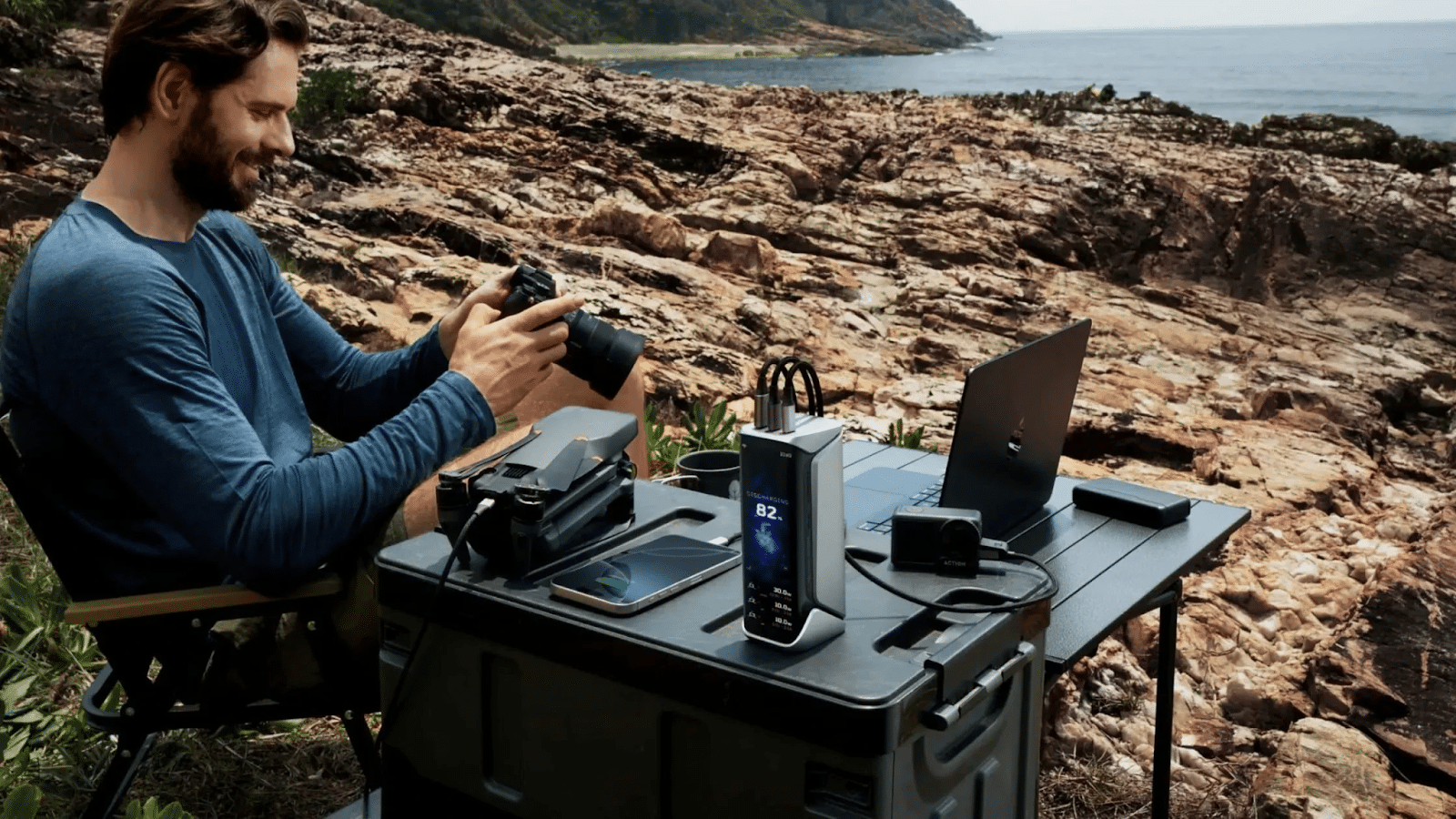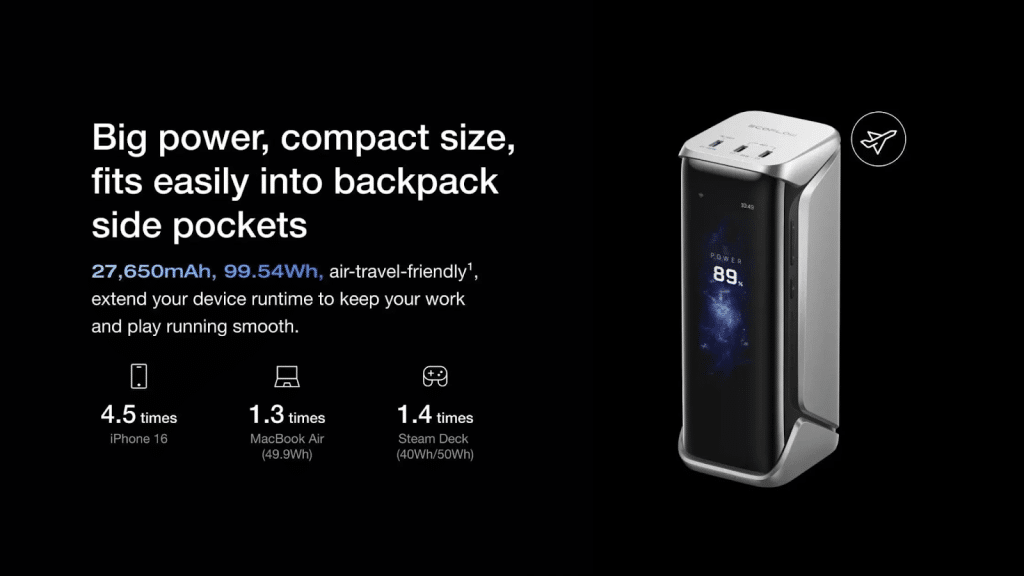Whether you’re catching a cross-country flight or heading off-grid for a weekend, a reliable power bank can make or break your trip. From keeping your phone alive at the airport to recharging your camera in the mountains, portable power is a must-have for travelers today.
But not all power banks are made equal—and when you’re flying, not all of them are allowed. Let’s look at what makes a truly travel-ready power bank and how to pick one that balances size, safety, and airline compliance.
Why a Travel Power Bank Matters
Modern travel depends on devices: smartphones for navigation, tablets for entertainment, cameras for memories, and laptops for work. Yet airports, buses, and remote destinations often leave you fighting for outlets—or without any at all.
That’s where a travel-friendly power bank steps in. It gives you freedom to work, communicate, and relax anywhere, without worrying about finding a plug or running out of juice halfway through a layover.
A great travel power bank isn’t just powerful—it’s portable, safe, and compliant with global flight regulations.
1. Finding the Right Size and Capacity
The first thing travelers notice is size—because every inch and ounce counts in a carry-on. But “size” isn’t just about physical dimensions; it’s also about battery capacity, measured in milliamp-hours (mAh) or watt-hours (Wh).
Understanding Capacity
- Small (5,000–10,000 mAh): Ideal for short trips or backup use. Can charge a smartphone 1–2 times. Fits in a pocket.
- Medium (10,000–20,000 mAh): Best for daily travelers. Charges a phone multiple times or a tablet once. Balances power and portability.
- Large (20,000–27,000 mAh): Suitable for longer journeys or when charging laptops. Still allowed on planes if under airline limits.
For frequent flyers, 10,000–20,000 mAh is the sweet spot—it keeps devices powered all day without adding bulk to your bag.
Why Wh Matters for Flights
Airlines regulate batteries by watt-hour (Wh) capacity, not mAh. You can convert using this formula:
Wh = (mAh ÷ 1000) × Voltage (usually 3.7 V)
Example:
20,000 mAh × 3.7 V ÷ 1000 = 74 Wh
That’s important because most airlines only allow power banks under 100 Wh in carry-on baggage. Anything above may require airline approval—or be refused entirely.
So before buying a high-capacity model, check its Wh rating on the label or product page.
2. Weight and Portability
Nobody wants to haul around a brick. A good travel power bank should be lightweight enough to carry all day but powerful enough to last through multiple charges.
Here’s a quick comparison:
| Capacity | Average Weight | Portability |
|---|---|---|
| 10,000 mAh | 6–8 oz (170–230 g) | Easily pocketable |
| 20,000 mAh | 12–16 oz (340–450 g) | Fits in backpack or purse |
| 26,800 mAh | ~1 lb (450 g+) | Best for long trips |
If you’re traveling internationally, smaller models also make it easier to clear airport security—no questions asked.
3. Power Output: Make Sure It’s Fast Enough
A compact power bank is only useful if it can recharge your devices efficiently. That’s where wattage and charging standards like USB-C PD (Power Delivery) or Quick Charge (QC) come in.
- Phones & tablets: Look for at least 18 W fast charging support.
- Laptops (USB-C models): Choose 45 W to 65 W output or higher.
- Multi-device charging: Total output should be at least 30–60 W combined.
The best travel chargers now include dual or triple ports—so you can power your phone, earbuds, and tablet simultaneously without slowing down.
4. Safety Standards and Battery Quality
When you’re traveling, the last thing you want is a cheap battery overheating in your bag. A trustworthy power bank should prioritize safety through design, materials, and certifications.
Key Safety Features to Look For
- Overcharge protection: Stops charging automatically when your device is full.
- Short-circuit protection: Prevents damage if cables or connectors fail.
- Temperature control: Shuts down charging if the battery gets too hot.
- Overcurrent/overvoltage safeguards: Keeps both the device and power bank safe.
Additionally, look for safety certifications such as UL, CE, FCC, or RoHS on the product or packaging—these indicate compliance with international standards.
Battery Type Matters
Lithium-ion and lithium-polymer are the two main types of cells in power banks.
- Lithium-ion: Higher energy density, slightly heavier, longer lifespan.
- Lithium-polymer (Li-Po): Slimmer, lighter, less heat generation.
For travel, Li-Po batteries are often preferred—they’re safer under pressure changes and less prone to swelling.
5. Airline and TSA Rules for Power Banks
This is the most crucial part travelers overlook. Airlines have strict regulations on where and how you can carry power banks onboard.
TSA and FAA Guidelines (for U.S. Flights)
- Carry-on only: Power banks are not allowed in checked baggage. You must pack them in your carry-on or personal item.
- Capacity limit:
- Up to 100 Wh – freely allowed.
- 100–160 Wh – allowed only with airline approval.
- Over 160 Wh – prohibited on passenger aircraft.
- Quantity: Usually limited to two spare batteries per person (check specific airline policies).
- Terminals: Should be protected from short circuits—use covers or store separately.
These rules also apply internationally, as most global carriers follow IATA (International Air Transport Association) guidelines.
Pro Tip: Label Visibility
Airline staff may check your battery’s Wh rating at security or boarding gates. Choose a model with clearly printed capacity labels—it saves time and avoids confusion.

6. Design Details That Matter for Travelers
Beyond wattage and safety, the best travel power banks also shine in usability.
- Pass-through charging: Lets you charge your devices and the power bank simultaneously—perfect for airports or hotels.
- Digital display: Shows precise battery percentage instead of vague LED dots.
- Integrated cables: Some compact models include built-in USB-C or Lightning cords—fewer items to forget.
- Durable casing: Scratch-resistant or rubberized finishes protect against bumps and drops during transit.
- Multi-port flexibility: USB-C + USB-A ports ensure compatibility with both new and old devices.
For adventure travel, look for IP-rated water and dust resistance—ideal for hiking, camping, or photographing outdoors.
7. Charging the Power Bank Itself
It’s easy to forget that your power bank needs charging, too. On long trips, recharging speed becomes just as important as output speed.
- Standard input: 5 V / 2 A (slow; 6–8 hours for a full charge).
- USB-C PD input: Up to 45–60 W (recharges in 2–3 hours).
- Dual input ports: Allow charging via both micro-USB and USB-C for convenience.
If your trip includes multiple flights or transfers, fast recharging means you’ll always have full power ready between destinations.
8. Eco-Friendly and Smart Options
As sustainable travel gains momentum, more travelers want gear that’s efficient and environmentally conscious. Some power banks now feature:
- Solar recharging panels for outdoor use.
- Recycled aluminum or bio-based plastic shells.
- Auto-sleep and smart energy-saving modes that reduce standby drain.
While solar charging is slow, it’s a valuable emergency backup for long outdoor adventures.
9. Common Travel Mistakes to Avoid
Even experienced travelers slip up with portable chargers. Here are a few to watch out for:
❌ Packing your power bank in checked luggage — it can be confiscated.
❌ Buying unbranded batteries with no certifications — safety risk and airline rejection.
❌ Forgetting the right cables — USB-C, Lightning, or adapters.
❌ Ignoring recharge time — large-capacity banks can take 8+ hours to refill.
❌ Not checking regional plug standards — you’ll need the right adapter to recharge it abroad.
A little preparation prevents airport stress and ensures uninterrupted power on the go.
10. Examples of Travel-Friendly Specs
Here’s what a “perfect” travel power bank might look like:
| Feature | Ideal Range / Description |
|---|---|
| Capacity | 10,000–20,000 mAh (37–74 Wh) |
| Output | 30–65 W USB-C PD |
| Ports | 2–3 total (USB-C + USB-A) |
| Weight | Under 1 lb (450 g) |
| Safety Features | Overcharge, short circuit, temperature protection |
| Certifications | UL, CE, FCC, RoHS |
| Airline Compliance | Under 100 Wh, labeled clearly |
| Extras | Digital display, pass-through charging, integrated cables |
This kind of setup provides enough energy for phones, tablets, cameras, and even some laptops—without violating flight rules.
11. Bonus Tip: Regional Travel and Power Frequency
When traveling internationally, remember that recharging your power bank still depends on local electricity standards. Many countries use 220–240 V outlets instead of 110 V.
Bring a universal adapter with USB-C PD support and at least 45 W output. That way, you can recharge both your power bank and devices anywhere without damaging them.
Conclusion
A great travel power bank combines just the right balance of capacity, weight, and safety—and follows every airline rule so you never run into trouble at the gate.
Before your next trip, look for one that’s under 100 Wh, fast-charging, and safety-certified. With the right model, you’ll stay powered through flights, road trips, and adventures around the world—no outlet required.
